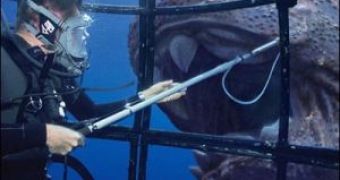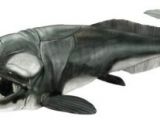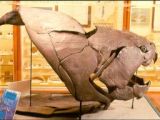Placoderm fishes were the first group of jawed vertebrates, and dominated aquatic ecosystems between 430 and 360 million years ago.
These early fishes were covered in a bonny armor that protected them (placoderm = "armored skin"). The biggest placoderm ever found is Dunkleosteus terrelli, which, with its 33 feet (10 m) length and 4 tons must have been a terrific top predator on the ancient oceans.
Now, biologists making biomechanical reconstruction of the jaws muscles of this fish, suggest that this creature might have had the most powerful bite of any fish ever, surpassing the biggest sharks and rivaling crocodiles or extinct Tyranosaurus dinosaur.
The scientists calculated a jaw power bite of 11,000 pounds, enough to brake the toughest shells and bones from the ocean. But the jaw of Dunkleosteus supported on the front a formidable array of bladed teeth, and the pressure measured at the tip of its fangs of 80,000 pounds per square inch. The biomechanical model of the fish mouth revealed that it had a highly mobile skull controlled by a unique mechanism based on four rotational joints, the secret behind its strong bite.
Moreover, this fish could also open its mouth very quickly, in just one fiftieth of a second, which created a strong suction force, pulling passing prey into its mouth. Usually, a fish has either a powerful bite or a fast bite, but not both. "The most interesting part of this work for me was discovering that this heavily armored fish was both fast during jaw opening and quite powerful during jaw closing," said Mark Westneat, Curator of Fishes at The Field Museum.
"This is possible due to the unique engineering design of its skull and different muscles used for opening and closing. And it made this fish into one of the first true apex predators seen in the vertebrate fossil record."
The powerful bite of Dunkleosteus would have allowed it to feed on other armored aquatic creatures like other placoderm fishes, ammonoids (ancient shelled squids), other mollusks, arthropods. "Dunkleosteus was able to devour anything in its environment," said Philip Anderson, at the Department of Geophysical Sciences at the University of Chicago.
Shark, which descended from ancestral placoderms, developed bladed jaws able to rip apart prey larger than its own mouth only 100 million years later. "Overall, this study shows how useful mechanical engineering theory can be in studying the behavior of fossil animals," added Anderson.
"We cannot actually watch these animals feed or interact, but we can understand the range of possible behaviors by examining how the preserved parts are shaped and connected to each other."

 14 DAY TRIAL //
14 DAY TRIAL // 

